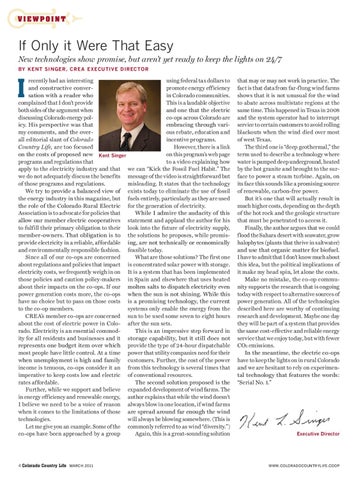If Only it Were That Easy New technologies show promise, but aren’t yet ready to keep the lights on 24/7 BY KENT SINGER, CRE A E XECUTIVE DIRECTOR
I
recently had an interesting using federal tax dollars to and constructive converpromote energy efficiency sation with a reader who in Colorado communities. complained that I don’t provide This is a laudable objective both sides of the argument when and one that the electric discussing Colorado energy polco-ops across Colorado are icy. His perspective was that embracing through varimy comments, and the overous rebate, education and all editorial slant of Colorado incentive programs. Country Life, are too focused However, there is a link on the costs of proposed new Kent Singer on this program’s web page programs and regulations that to a video explaining how apply to the electricity industry and that we can “Kick the Fossil Fuel Habit.” The we do not adequately discuss the benefits message of the video is straightforward but of those programs and regulations. misleading. It states that the technology We try to provide a balanced view of exists today to eliminate the use of fossil the energy industry in this magazine, but fuels entirely, particularly as they are used the role of the Colorado Rural Electric for the generation of electricity. Association is to advocate for policies that While I admire the audacity of this allow our member electric cooperatives statement and applaud the author for his to fulfill their primary obligation to their look into the future of electricity supply, member-owners. That obligation is to the solutions he proposes, while promisprovide electricity in a reliable, affordable ing, are not technically or economically and environmentally responsible fashion. feasible today. Since all of our co-ops are concerned What are those solutions? The first one about regulations and policies that impact is concentrated solar power with storage. electricity costs, we frequently weigh in on It is a system that has been implemented those policies and caution policy-makers in Spain and elsewhere that uses heated about their impacts on the co-ops. If our molten salts to dispatch electricity even power generation costs more, the co-ops when the sun is not shining. While this have no choice but to pass on those costs is a promising technology, the current to the co-op members. systems only enable the energy from the CREA’s member co-ops are concerned sun to be used some seven to eight hours about the cost of electric power in Colo- after the sun sets. rado. Electricity is an essential commodThis is an impressive step forward in ity for all residents and businesses and it storage capability, but it still does not represents one budget item over which provide the type of 24-hour dispatchable most people have little control. At a time power that utility companies need for their when unemployment is high and family customers. Further, the cost of the power income is tenuous, co-ops consider it an from this technology is several times that imperative to keep costs low and electric of conventional resources. rates affordable. The second solution proposed is the Further, while we support and believe expanded development of wind farms. The in energy efficiency and renewable energy, author explains that while the wind doesn’t I believe we need to be a voice of reason always blow in one location, if wind farms when it comes to the limitations of those are spread around far enough the wind technologies. will always be blowing somewhere. (This is Let me give you an example. Some of the commonly referred to as wind “diversity.”) co-ops have been approached by a group Again, this is a great-sounding solution
4 Colorado Country Life MARCH 2011
that may or may not work in practice. The fact is that data from far-flung wind farms shows that it is not unusual for the wind to abate across multistate regions at the same time. This happened in Texas in 2008 and the system operator had to interrupt service to certain customers to avoid rolling blackouts when the wind died over most of west Texas. The third one is “deep geothermal,” the term used to describe a technology where water is pumped deep underground, heated by the hot granite and brought to the surface to power a steam turbine. Again, on its face this sounds like a promising source of renewable, carbon-free power. But it’s one that will actually result in much higher costs, depending on the depth of the hot rock and the geologic structure that must be penetrated to access it. Finally, the author argues that we could flood the Sahara desert with seawater, grow halophytes (plants that thrive in saltwater) and use that organic matter for biofuel. I have to admit that I don’t know much about this idea, but the political implications of it make my head spin, let alone the costs. Make no mistake, the co-op community supports the research that is ongoing today with respect to alternative sources of power generation. All of the technologies described here are worthy of continuing research and development. Maybe one day they will be part of a system that provides the same cost-effective and reliable energy service that we enjoy today, but with fewer CO2 emissions. In the meantime, the electric co-ops have to keep the lights on in rural Colorado and we are hesitant to rely on experimental technology that features the words: “Serial No. 1.”
Executive Director
WWW.COLORADOCOUNTRYLIFE.COOP
